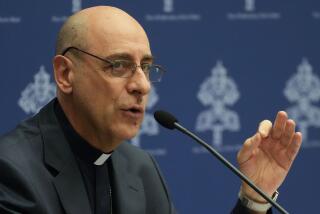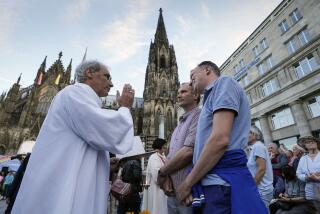Vatican Document Accepts Some ‘Liberation Theology’
- Share via
VATICAN CITY — In a major document aimed at defining “liberation theology” in terms more acceptable to conservatives in the Roman Catholic Church hierarchy, the Vatican on Saturday upheld some ideas of the controversial theological movement, including armed struggle “as a last resort to put an end to an obvious and prolonged tyranny.”
But the 59-page, 15,000-word pronouncement, long awaited as a formal guide to “positive” elements of liberation theology, stressed that while the church seeks the political, social and economic liberation of the downtrodden, its primary goal is the spiritual one of liberation from evil.
“It is not for the pastors of the church to intervene directly in the political construction and organization of social life,” the document, entitled “Instruction on Christian Freedom and Liberation,” declared, echoing the long-held view of Pope John Paul II that priests should stay out of politics, even in deeply troubled societies.
Liberation theology takes an activist view of the church’s role in achieving social justice, blending liberal objectives of greater social and economic equality with, in some cases, Marxist and violent methods of achieving such aims. It has been particularly controversial in the Latin American church, sometimes dividing conservative bishops, who oppose the practice, from younger priests, who feel that they must respond to the extreme poverty of their parishioners.
The document issued Saturday extolled passive resistance as a weapon against tyranny and said that leadership in the struggle for social change should come from laymen “guided by Christian conscience.”
Briefing reporters on the document Saturday, a senior Vatican cleric sidestepped the matter of Philippine Cardinal Jaime Sin’s political role in the ouster of President Ferdinand E. Marcos, a clerical intervention that the new statement would seem to condemn. But the clergyman said that “what took place in the Philippines comes within the definition of passive resistance.”
The church document--despite its acceptance of armed struggle as a last resort and only after “very rigorous analysis”--rejected violence as a means to liberation.
“Systematic recourse to violence put forward as the necessary path to liberation has to be condemned as a destructive illusion and one that opens the way to new forms of servitude,” it said. But it added that “one must condemn with equal vigor violence exercised by the powerful against the poor, arbitrary action by the police and any form of violence established as a system of government.”
A ‘Myth’ Debunked
It also decried what it called “the myth of revolution.”
“Those who discredit the path of reform and favor the myth of revolution not only foster the illusion that the abolition of an evil situation is in itself sufficient to create a more humane society,” the document said. “They also encourage the setting up of totalitarian regimes.”
The authoritative 15,000-word statement was prepared by Cardinal Joseph Ratzinger, who as head of the Sacred Congregation for the Doctrine of the Faith--the old Holy Office--is the Vatican’s formal ideologist, its theological watchdog.
Coupled with an earlier Ratzinger document in September, 1984, “Instruction on Certain Aspects of the Theology of Liberation,” the statement gives a sweeping view of Roman Catholic social doctrine, including a distaste for unbridled capitalism. Stressing what it called “the priority of work over capital,” the document praised the dignity of labor and said that “in a sense, work is the key to the whole social question.”
“The solution to most of the serious problems related to poverty is to be found in the promotion of a true civilization of work,” it said.
But without specifically referring to Marxism, it cautioned against viewing society in terms of class struggle, as some radical exponents of liberation theology have expressed it.
“When the church encourages the creation and activity of associations such as trade unions, which fight for the defense of the rights and legitimate interests of the workers and for social justice, she does not thereby admit the theory that sees in the class struggle the structural dynamism of social life,” the statement declared.
Instead, it said, “the Christian will always prefer the path of dialogue and joint action. . . . Liberation in the spirit of the Gospel is therefore incompatible with hatred of others, taken individually or collectively, and this includes hatred of one’s enemy.”
Balance Tipped to Workers
However, in balancing the worker-employer equation, the Vatican statement stood firmly on the side of the worker. “The priority of work over capital places an obligation in justice upon employers to consider the welfare of the workers before the increase of profits,” it said. “The right to private property is inconceivable without responsibilities to the common good.”
John Paul’s speeches on the subject of liberation theology during the last three years, and the two Ratzinger documents, have been interpreted by some Catholic liberals as attempts by the Pope and by conservatives in the church hierarchy to co-opt radical theologians by adopting the title of their movement and elements of their teachings while condemning the movement’s violent or purely political aspects.
“The Ratzinger documents are trying to subtract the political and add the transcendent to liberation theology,” a priest based at the Vatican said, adding that the main thrust of the documents was to make the church hierarchy’s definition of liberation theology the only acceptable one.
More to Read
Sign up for Essential California
The most important California stories and recommendations in your inbox every morning.
You may occasionally receive promotional content from the Los Angeles Times.













